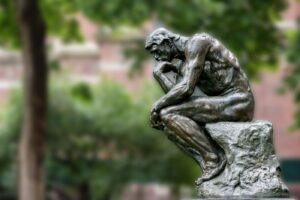Earlier this month an astrobiologist from NASA, Felisa Wolfe-Simon, reported that bacteria from the bottom of Lake Mono in California had been nourished in a laboratory for several months on a diet rich in arsenic. If true, her claim that atoms of arsenic replaced phosphorus in these microbes would call into question traditional biological wisdom that phosphorus is one of the six chemical elements necessary for life. In an essay in Science, Wolfe-Simon argued that the alleged discovery of an arsenic-eating organism requires us to accept the possibility that organisms exist in the universe (including here on Earth) which are well beyond our present imagination. Reports in the media suggest that we need to redefine our understanding of life.
There is now a major debate about the validity of Wolfe-Simon’s findings, but her claims have brought back to public attention an older and deeper debate about the definition of life. Questions concerning the nature of living things precisely as living have currency, in part, because of the persistence in modern science of various materialist, mechanistic, and reductionist accounts of living and non-living entities: indeed, of the elimination of any real, qualitative distinction between the living and the non-living. Three years ago the editors of Nature made the following sweeping observation:
There is a popular notion that life is something that appears when a clear threshold is crossed. One might have hoped that such perceptions of a need for a qualitative difference between inert and living matter—such vitalism—would have been interred alongside the pre-Darwinian belief that organisms are generated spontaneously from decaying matter. Scientists who regard themselves as well beyond such beliefs nevertheless bolster them when they attempt to draw up criteria for what constitutes ‘life.’ It would be a service to more than synthetic biology if we might now be permitted to dismiss the idea that life is a precise scientific concept.
Many biologists who insist that living things are nothing more than the sum of their physical components conclude that a question such as “what is life?” is at the very least not a biological question, and probably is best rejected as a question without content. So we hear that one ought to resist using the term “life” to describe what is just a highly sophisticated movement of matter. In an important sense, according to such a view, “life,” as something other than matter in motion, does not exist. For those scientists and philosophers who embrace some form of materialism there is a strict disjunction: either we explain the living in terms of material, mechanically operating constituents, or in terms of some mysterious spiritual substance, some vital force. There is no substitute to materialism but magic.
There is among some biologists and natural philosophers another view of life that emphasizes not so much the material components, but a specific form or structure that is the source of the organization of matter. Life, in the views of these thinkers, is seen as a form of organization of matter; it is not merely the sum of specifically determined material parts, such as, for example, molecules like DNA, or proteins, or specific chemical elements, such as carbon. Accordingly, since structure is the key to life, it would be possible, at least in theory, to fabricate life on the basis of a different material substrate—that is, to apply a special structural form to other material elements: to create “artificial life.”
Start your day with Public Discourse
Sign up and get our daily essays sent straight to your inbox.Even without appealing to strange new kinds of life, biologists have become increasingly aware of the inadequacy of reductionist explanations of life. They now speak of a phenomenon called “emergence.” According to the theory of emergence, a “higher level property” is said to be “emergent” when it is irreducible to the material constituents from which the property ultimately derives. Thus, the properties characteristic of living beings, precisely as living, emerge from the material constituents, but are not reducible to these constituents. Yet, if we were to pose the question of reductionism to those who support the notion of emergence they tend to affirm that there is nothing more to living things—indeed, to all things—than their material constituents. Theories of emergence can only affirm, but not explain, the activity that proceeds from the whole, precisely as the whole. So long as emergence remains unable to account for what makes the whole to be the single entity it is—and thus the source of its characteristic activities—the tendency will be to fall back into a form of reductionism, attributing to the parts a more fundamental reality than the whole.
Important in this respect is the “more is different” description found in various theories of emergence. First of all, this “more” is obviously not the material “more,” nor a mere re-arrangement of existing parts. If it were, the “more” would not really be different. But a new kind of entity does emerge as a result of this “more.” For example, when hydrogen and oxygen combine to form water, there is something more to the new reality than merely the sum of the properties of the material constituents. Reductionism cannot account for the new reality, nor can it recognize that reproduction among living things has an autonomy which is not reducible to physical or chemical change. Cell division, for example, terminates in neither the modification of a physical property nor in a new chemical compound with a new set of properties. The two daughter cells resulting from mitosis are qualitatively alike and individual members of the same species. Physical and chemical changes are indeed involved in reproduction, and an adequate scientific account must include them; nevertheless, reproduction is not reducible to either or both.
In what follows I want to offer a sketch of how natural philosophy in the tradition of Aristotle and Thomas Aquinas can help us to understand the emergence and nature of living things: an understanding which complements recent developments in the natural sciences. In particular, their explanation of the soul as the informing principle of living things, which distinguishes the living from the non-living, is crucial. It is an explanation which does not embrace a dualistic conception of life, entails no “vitalism,” and involves no “magic.”
Their analysis of the soul is an integral part of their explanation of living things, which is itself part of an even broader understanding of the distinction between form and matter, the co-principles of all physical reality. Form and matter are not two different things, but two explanatory principles, two ways according to which the reality of the natural substance must be understood if it is to be understood completely. Each individual substance, inanimate and animate, must have an informing principle, and the differences among informing principles are correlative to the differences among existing substances. Soul (psyche or anima) is the term used to indicate the form of a living thing, and Aristotle and Thomas distinguish among the souls characteristic of plants, those of animals, and those of human beings. Even the arsenic-eating microbe from Lake Mono has a soul.
We might remember here a famous remark by Aristotle: “There is no part of an animal which is purely material or purely immaterial.” Soul is not something added to, or which falls inside, or is united to a physical thing. Soul is what makes a living being the kind of living thing it is. What opponents of dualism and vitalism often do not see is that Aristotle and Thomas offer an alternative view of nature and human nature which would honor the discoveries of contemporary science while avoiding the errors of materialism and dualism; and they have a way of accounting for the “more” which modern science recognizes. The actuality or form of the whole entity is different from the matter that makes up the thing. It would be insufficient merely to inquire of a natural substance what it is made of, just as it would be incomplete to inquire of a natural substance only what it is as a whole.
The soul is not some kind of foreign substance that is added to the bodily elements. Rather the soul is the actuality of the whole: not separate from the whole, but an expression of the fact that the whole is a new reality, not reducible to its material constituents. The soul or form is not some outer shell or structure; it is the intrinsic determining principle which actualizes the potentiality of matter and thus radically constitutes an entity as a single, individual thing. The soul is a more complicated sort of form than what is found in non-living bodies, and it is not imposed upon a substance but is rather a genuine part (albeit not a material part) of the substance. It is the soul which causes the body to be a unitary, self-subsistent, living being. The various activities in which a living being engages (“second actualities”) could not exist without the first actualization by the soul. To think of the composite, inanimate or animate, in reductively material terms, is simply to fail to think of the whole reality.
It is important here to reflect on what it means for a natural entity—in biology, a living entity—to be the one thing which it is, and how, thus, to account for this unity. In order to understand the causal activity of a living organism, as proponents of emergence wish to do, one needs first to establish that the whole organism exists as something more than an incidental arrangement of parts. It is precisely here—in understanding the way in which an organism is a unity—that the Aristotelian and Thomistic idea of soul is so important. If we want to give an answer to the question of what is life, and this question is really one in the philosophy of nature, and not a question for the specialized techniques of biological research, then the answer must include the whole reality of life: it must include the constituents and the whole.
Of course, a biologist need not have a precise philosophical definition of life. Still, discoveries of new and unusual forms of life, like the bacterium nourished by arsenic, make us wonder what life truly is. If the biologist wishes to think philosophically, he should realize that vitalism and reductionism are not the only possible choices. With Aristotle and Thomas, the biologist turned philosopher should reject both vitalism and ontological reductionism. As a biologist he knows that the living whole is somehow more than its chemical constituents (whatever they might be); as a philosopher he can know that this something more can be explained non-dualistically with a proper understanding of the soul.










